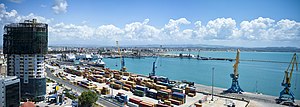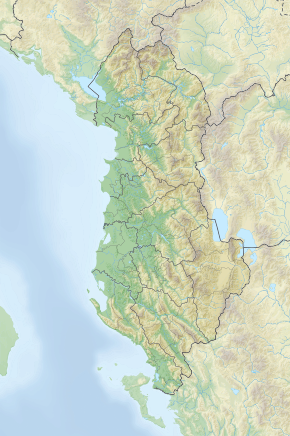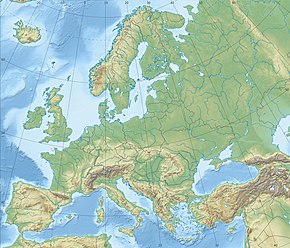Durrës
Durrës | |
|---|---|
Municipality and city | |
|
Clockwise from top: Panorama of Durrës, Mosaics at a Basilica within the Amphitheatre, Venetian Tower, Albanian College, Church of Saint Asti and Apostle Paul, Ancient Walls, Amphitheatre, Iliria Square. | |
| Coordinates: 41°18′48″N 19°26′45″E / 41.31333°N 19.44583°E | |
| Country | Albania |
| Region | Northern Albania |
| County | Durrës |
| Founded | 7th century BC |
| Government | |
| • Type | Mayor–council |
| • Body | Durrës Municipal Council |
| • Mayor[1] | Emiriana Sako (PS) |
| Area | |
| • Municipality[2][3] | 338.30 km2 (130.62 sq mi) |
| Elevation | 0 m (0 ft) |
| Population (2011) | |
| • Municipality | 175,110[a] |
| • Municipality density | 517/km2 (1,340/sq mi) |
| • Administrative unit | 113,249[b] |
| Demonym | Durrsak(e) (Albanian) |
| Time zone | UTC+01:00 (CET) |
| • Summer (DST) | UTC+02:00 (CEST) |
| Postal code | 2000 |
| Area code | +355 (0) 52 |
| Seaport | Port of Durrës |
| Motorways | |
| Highways | |
| Vehicle registration | DR |
| Website | Durrës.gov.al |
Durrës (
Durrës was founded by Ancient Greek colonists from Corinth and Corcyra under the name of Epidamnos around the 7th century BC in cooperation with the local Illyrian tribe Taulantii.[10][11] Also known as Dyrrachium, Durrës essentially developed as it became an integral part of the Roman Empire and its successor the Byzantine Empire. The Via Egnatia started in the city and led east across the fields, lowlands and highlands of the Balkan Peninsula to Constantinople.
In the
The transport connections, concentration of economic institutions and industrial tradition underlie Durrës' leading economic position in Albania. It is served by the
Name
In antiquity, the city was known as Epidamnos (Ἐπίδαμνος) and Dyrrhachion (Δυρράχιον) in
The name Dyrrhachion is usually explained as a Greek compound from δυσ- 'bad' and ῥαχία 'rocky shore, flood, roaring waves',
The modern names of the city in Albanian (Durrës) and Italian (Durazzo, Italian pronunciation:
In English usage, the Italian form Durazzo used to be widespread, but the local Albanian name Durrës has gradually replaced it in recent decades.
History
Earliest period
The territory of Durrës was populated at least starting from the
Antiquity
Though surviving remains are minimal,[29] Durrës is one of the oldest cities in Albania. In terms of mythology, the genealogy of the foundation of Dyrrhachium includes among the founders Illyrian men (the Illyrian king Epidamnos and his grandson Dyrrachos), Greek men (the Corinthian Falio, descendant of Heracles), heroes (Heracles who was given part of the lands) and gods (Poseidon, as father of Dyrrachos).[30][31]
Several ancient people held the site: the presence of the
After 323 BC Epidamnus-Dyrrhachium was involved in the intervention in Illyria of the Macedonians under
Epidamnus came under the control of the Illyrian
at the same year.
For
After the
In the 4th century, Dyrrachium was made the capital of the
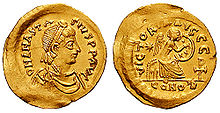
Like much of the rest of the
Middle Ages
The city and the surrounding coast became a Byzantine province, the
In the 11th–12th centuries, the city was important as a military stronghold and a
In 1205, after the
In the early 14th century, the city was ruled by a coalition of Anjous, Hungarians, and Albanians of the Thopia family. In 1317 or 1318, the area was taken by the Serbs and remained under their rule until the 1350s. At that time the Popes, supported by the Anjous, increased their diplomatic and political activity in the area, by using the Latin bishops, including the archbishop of Durrës. The city had been a religious center of Catholicism after the Anjou were installed in Durrës. In 1272, a Catholic archbishop was installed, and until the mid-14th century there were both Catholic and Orthodox archbishops of Durrës.[50]
Two Irish pilgrims who visited Albania on their way to Jerusalem in 1322, reported that Durrës was "inhabited by Latins, Greeks, perfidious Jews and barbaric Albanians".[51]
When the Serbian Tsar
in 1466 but fell to Ottoman forces in 1501.Ottoman period (to 1912)
Under Ottoman rule, many of its inhabitants converted to Islam and many mosques were erected. The city was renamed Dırac (دراج) but did not prosper in the first two centuries of the Ottoman era; its importance declined greatly and it became a den of piracy. Following the establishment of Ottoman rule in 1501, the Durrës Jewish community experienced population growth.[49]


As a port, Durrës was of little importance to the Ottomans, who controlled the entire Albanian coast. The town's main significance rather lay in
The city's economy began to recover from the late 17th century onwards, boosted by profits from the salt mines, which exported salt throughout the Balkan hinterland. According to diplomat and Turkologist François Pouqueville, about 100 Turkish and Greek merchants lived in the city in 1699, exporting 3,000 quintals (300 tons) of beeswax, 15,000 quintals (1,500 tons) of finished cloth, 15,000 pieces of fine leather, and 60-100 ships of wheat, barley, corn and millet to Venice every year despite an official prohibition from the central government in Constantinople.[54] France, England, the Netherlands, and Austria established their consulates in Durrës in 1700.
As Ottoman relations with Venice improved upon the conclusion of the
By the mid-19th century, its population was said to have been about 1,000 people living in some 200 households. In the late nineteenth century, Durrës contained 1,200 Orthodox Aromanians (130 families) who lived among the larger population of Muslim Albanians alongside a significant number of Catholic Albanians.[56] The decrepitude of Durrës was noted by foreign observers in the early 20th century, echoing comments made by the Ottoman cartographer Piri Reis almost 400 years before: "The walls are dilapidated; plane-trees grow on the gigantic ruins of its old Byzantine citadel; and its harbour, once equally commodious and safe, is gradually becoming silted up."[57]

During the
On 26 November 1912, as the Ottoman Empire was embroiled in the
Modern

Durrës was an active city in the
During the

An earthquake in 1926 damaged some of the city and the rebuilding that followed gave the city its more modern appearance. During the 1930s, the Bank of Athens had a branch in the city.
Durrës (called Durazzo again in Italian) and the rest of Albania were
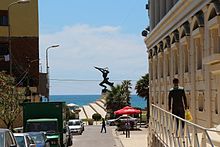

The
Following the collapse of communist rule in 1990, Durrës became the focus of mass emigrations from Albania with ships being hijacked in the harbour and sailed at gunpoint to Italy. In one month alone, August 1991, over 20,000 people migrated to Italy in this fashion. Italy intervened militarily, putting the port area under its control, and the city became the center of the
In 1997, Albania slid into anarchy following the collapse of a massive pyramid scheme which devastated the national economy. An Italian-led peacekeeping force was controversially deployed to Durrës and other Albanian cities to restore order, although there were widespread suggestions that the real purpose of "Operation Alba" was to prevent economic refugees continuing to use Albania's ports as a route to migrate to Italy.
Following the start of the 21st century, Durrës has been revitalized as many streets were repaved, while parks and façades experienced a face lift.
Geography
Durrës is located on the Bay of Durrës on a flat
Climate
According to the
| Climate data for Durrës | |||||||||||||
|---|---|---|---|---|---|---|---|---|---|---|---|---|---|
| Month | Jan | Feb | Mar | Apr | May | Jun | Jul | Aug | Sep | Oct | Nov | Dec | Year |
| Mean daily maximum °C (°F) | 11.4 (52.5) |
12.5 (54.5) |
14.9 (58.8) |
18.3 (64.9) |
22.6 (72.7) |
26.5 (79.7) |
28.7 (83.7) |
28.8 (83.8) |
26.0 (78.8) |
21.4 (70.5) |
16.6 (61.9) |
13.3 (55.9) |
20.1 (68.1) |
| Daily mean °C (°F) | 8.1 (46.6) |
9.0 (48.2) |
10.9 (51.6) |
14.0 (57.2) |
18.1 (64.6) |
21.8 (71.2) |
23.8 (74.8) |
23.9 (75.0) |
21.2 (70.2) |
17.2 (63.0) |
13.0 (55.4) |
9.9 (49.8) |
15.9 (60.6) |
| Mean daily minimum °C (°F) | 4.8 (40.6) |
5.6 (42.1) |
6.9 (44.4) |
9.7 (49.5) |
13.6 (56.5) |
17.2 (63.0) |
19.0 (66.2) |
19.0 (66.2) |
16.5 (61.7) |
13.0 (55.4) |
9.5 (49.1) |
6.5 (43.7) |
11.8 (53.2) |
| Average precipitation mm (inches) | 132 (5.2) |
107 (4.2) |
99 (3.9) |
81 (3.2) |
68 (2.7) |
41 (1.6) |
26 (1.0) |
36 (1.4) |
71 (2.8) |
112 (4.4) |
160 (6.3) |
131 (5.2) |
1,064 (41.9) |
| Average rainy days | 13 | 12 | 13 | 12 | 9 | 7 | 5 | 5 | 7 | 10 | 13 | 13 | 119 |
| Average relative humidity (%)
|
72 | 69 | 70 | 72 | 73 | 70 | 67 | 67 | 70 | 72 | 72 | 72 | 71 |
| Average dew point °C (°F) | 2 (36) |
2 (36) |
5 (41) |
8 (46) |
12 (54) |
16 (61) |
17 (63) |
17 (63) |
16 (61) |
12 (54) |
7 (45) |
4 (39) |
10 (50) |
| Mean monthly sunshine hours | 133.3 | 135.6 | 173.6 | 207 | 279 | 318 | 375.1 | 325.5 | 261 | 217 | 147 | 124 | 2,696.1 |
| Mean daily sunshine hours | 4.3 | 4.8 | 5.6 | 6.9 | 9 | 10.6 | 12.1 | 10.5 | 8.7 | 7 | 4.9 | 4 | 7.4 |
| Mean daily daylight hours | 9.6 | 10.6 | 12 | 13.4 | 14.5 | 15.1 | 14.8 | 13.8 | 12.5 | 11.1 | 9.9 | 9.2 | 12.2 |
| Average ultraviolet index | 2 | 2 | 4 | 6 | 8 | 9 | 9 | 8 | 6 | 4 | 2 | 1 | 5 |
| Source 1: Climate data(Temperatures-Precipitation-Humidity)[65] Weather Atlas(Daylight-UV-Rainy days[66]) | |||||||||||||
| Source 2: Weatherbase(Dew Point[67]) Weather2visit(Sunshine[68]) | |||||||||||||
Politics
Durrës is a municipality governed by a mayor–council system with the mayor of Durrës and the members of the Durrës Municipal Council being responsible for the administration of Durrës Municipality.[69] The mayor of Durrës is elected by its people to act as the executive officer of the municipality.[70] The Durrës Municipal Council is the legislative body of the municipality and is also a democratically elected institution, comprising 51 councillors since the latest municipal election.[70] Both, the mayor and members of the municipal council serve four-year terms without term limits.[70]
Economy
Durrës is an important link to Western Europe due to its port and its proximity to the Italian port cities, notably Bari, to which daily ferries run. As well as the dockyard, it also possesses an important shipyard and manufacturing industries, notably producing leather, plastic and tobacco products.
The southern coastal stretch of Golem is renowned for its traditional mass beach tourism having experienced uncontrolled urban development. The city's beaches are also a popular destination for many foreign and local tourists. In 2012, new water sanitation systems are being installed to eliminate sea water pollution. In contrast, the northern coastal stretch of Lalzit Bay is mostly unspoiled and set to become an elite tourism destination as a number of beach resorts are being built since 2009. Neighboring districts are known for the production of good wine and a variety of foodstuffs.
According to the World Bank, Durrës has made significant steps of starting a business in 2016. Durrës ranks ninth, Bosnia and Herzegovina.
Transportation

Major roads and railways pass through the city of Durrës thank to its significant location and connect the northern part of the country to the south and the west with the east. Durrës is the starting point of
The
The Port of Durrës, in the south-west of the city, is one of the major ports of the Adriatic Sea and plays a very important role in the city's economy. The port is located on an artificial basin that is formed between two moles, with a west-northwesterly oriented entrance approximately wide as it passes between the ends of the moles. The port is also a key location for transit networks and passenger ferry, giving Durrës a strategic position with respect to the Pan-European Corridor VIII. The port has experienced major upgrades in recent years culminating with the opening of the new terminal in July 2012. In 2012, The Globe and Mail ranked Durrës at no. 1 among 8 exciting new cruise ports to explore.[73] It is one of the largest passenger port on the Adriatic Sea that handle more than 1.5 million passengers per year.
The
A rail connection between Durrës and
Demography
| Population growth of Durrës in selected periods | |||||||
|---|---|---|---|---|---|---|---|
| Year | 1923[75] | 1927[75] | 1938[75] | 1979 | 1989 | 2001[76] | 2011[76] |
| Pop. | 4,785 | 5,175 | 10,506 | 66,200 | 82,719 | 99,546 | 113,249 |
| ±% p.a. | — | +1.98% | +6.65% | +4.59% | +2.25% | +1.56% | +1.30% |
| Source: [75][76] | |||||||
Durrës is the second most populous
Islam was introduced to the city in the early 16th century during the Ottoman conquest. Much of the local population converted to Islam during the four centuries of Ottoman rule. The two most well-known mosques in the city are the Great Mosque of Durrës (built in 1931 on the site of an earlier Ottoman mosque) and the Fatih Mosque, erected in 1502 just one year after the city became part of the Ottoman Empire.
Culture
The theatrical and musical life of the city is centered on the Aleksandër Moisiu Theatre, the Estrada Theatre, a puppet theatre, and the Philharmonic Orchestra. The annual International Film Summerfest of Durrës, founded in 2008, is held in late August or early September in the amphitheatre. In 2004 and 2009 Miss Globe International was held in Durrës.
The city is home to different architectural styles that represent influential periods in its history. The architecture is influenced by Illyrian, Greek, Roman and Italian architecture.[citation needed] In the 21st century, part of Durrës turned into a modernist city, with large blocks of flats, modern new buildings, new shopping centres and many green spaces.
Education

Durrës has a long tradition of education since the beginning of civil life from antiquity until today. After the fall of communism in Albania, a reorganization plan was announced in 1990, that would extend the compulsory education program from eight to ten years. The following year, major economic and political crisis in Albania, and the ensuing breakdown of public order, plunged the school system into chaos. Later, many schools were rebuilt or reconstructed, to improve learning conditions especially in larger cities of the country. Durrës is host to academic institutions such as the
One of the city's main sights is the Byzantine city wall, also called
Museums
Durrës is home to the largest archaeological museum in the country, the
International relations
In 2008,
These countries have an honorary consulate in Durrës:
Twin and sister cities
Durrës is
Cooperation and friendship
Durrës has cooperation and friendship relationships with:
See also
- List of ancient cities in Illyria
- List of mayors of Durrës
- List of people from Durrës
Notes
- ^ The municipality of Durrës consists of the administrative units of Ishëm, Katund i Ri, Manëz, Rrashbull, Sukth and Durrës.[2][4][5] The population of the municipality results from the sum of the listed administrative units in the former as of the 2011 Albanian census.[2][6]
- ^ The estimation for the administrative unit of Durrës is to be taken into consideration.[6]
References
- ^ "Historiku i Kryetareve" (in Albanian). Bashkia Durrës. Archived from the original on 10 October 2020. Retrieved 29 September 2021.
- ^ a b c "Pasaporta e Bashkisë Durrës" (in Albanian). Porta Vendore. Archived from the original on 29 September 2021. Retrieved 29 September 2021.
- ^ "Bashkia Durrës" (in Albanian). Albanian Association of Municipalities (AAM). Archived from the original on 5 December 2020. Retrieved 29 September 2021.
- ^ "A new Urban–Rural Classification of Albanian Population" (PDF). Instituti i Statistikës (INSTAT). May 2014. p. 15. Archived from the original (PDF) on 14 November 2019. Retrieved 29 September 2021.
- ^ a b "Law nr. 115/2014" (PDF) (in Albanian). p. 6368. Archived (PDF) from the original on 25 February 2022. Retrieved 25 February 2022.
- ^ a b c Nurja, Ines. "Censusi i popullsisë dhe banesave/ Population and Housing Census–Durrës (2011)" (PDF). Tirana: Institute of Statistics (INSTAT). p. 85. Archived (PDF) from the original on 27 March 2020. Retrieved 29 September 2021.
- ^ "Durrës". Lexico UK English Dictionary. Oxford University Press. Archived from the original on 6 July 2020.
- ^ "Durrës". The American Heritage Dictionary of the English Language (5th ed.). HarperCollins. Retrieved 5 July 2020.
- ^ Sedlar 2013, p. 111.
- ^ a b Grote, George (2013). A History of Greece: From the Time of Solon to 403 BC. Routledge. p. 440.
- ^ Stallo 2007, p. 29.
- ^ Shehi 2017, p. 108.
- ^ a b Demiraj 2006, p. 126.
- ^ Demiraj 1997, pp. 128–29.
- ^ Cabanes 2008, pp. 166, 169
- ^ Demiraj 2006, p. 127.
- ^ Krahe, Hans (1964). "Vom Illyrischen zum Alteuropäischen". Indogermanische Forschungen. 69: 202.
- ^ Dio, Cassius (1916). "41:49". Roman History. Vol. IV. Loeb Classical Library. p. 85. Archived from the original on 20 January 2024. Retrieved 19 February 2021.
- ^ Demiraj 2006, p. 128.
- ^ Demiraj 2006, p. 129.
- ^ Shehi 2017, p. 110.
- ^ Shehi 2017, p. 107.
- ^ a b Demiraj 2006, pp. 133–34
- ^ Demiraj 2006, p. 132.
- ^ Bonnet, Guillaume (1998). Les mots latins de l'albanais (in French). Paris: L'Harmattan. p. 37.
- ^ "Arumunët Albania, nr. 40". Arumunët Albania (in Albanian and Aromanian). No. 40. 2014. p. 15. Archived from the original on 29 August 2022. Retrieved 29 August 2022.
- ^ Sezen, Tahir (2017). "Osmanlı Yer Adları (Ottoman Place Names)" (Document) (in Turkish). Ankara: Directorate of State Archives. p. 217.
- ^ Sassi 2018, p. 942
- ^ A selection of modern travelers' accounts and references in ancient literature are given in P. Cabanes and F. Drini, eds, Inscription d'Épidamne-Dyrrhachion et d'Apollonia, vol. I (1995)
- ^ Sassi 2018, pp. 951–952.
- ^ Wilkes 1995, p. 111
- ISBN 0-521-22496-9. Archivedfrom the original on 15 January 2023. Retrieved 10 August 2019.
- ^ a b Wilkes 1995, p. 111: In a later period the Bryges, returning from Phrygia, seized the city and surrounding territory, then the Taulantii, an Illyrian people, took it from them and the Liburni, another Illyrian people, took it from the Taulantii [...] Those expelled from Dyrrhachium by the Liburnians obtained help from the Corcyreans then masters of the sea and drove out the Liburni.
- ^ Cabanes 2008, p. 163.
- ^ Wilkes 1995, p. 112.
- ^ Cabanes 2008, p. 271.
- ^ a b Cabanes 2008, p. 179
- ^ Crawford 1985, pp. 220–221; Šašel Kos 2005, p. 258.
- ^ Šašel Kos 2002, p. 109
- ^ Wilkes 1995, p. 158
- ^ Wilkes 1995, p. 161: "... Gulf of Kotor. The Romans decided that enough had been achieved and hostilities ceased. The consuls handed over Illyria to Demetrius and withdrew the fleet and army to Epidamnus, ..."
- ISBN 1-85367-389-7.
- ^ M. Gwyn Morgan, "Catullus and the 'Annales Volusi'" Quaderni Urbinati di Cultura Classica, New Series, 4 (1980):59–67).
- ISBN 978-0-7156-3201-7. Archivedfrom the original on 3 February 2023. Retrieved 2 November 2020.
But there is no reason to disbelieve Justinian's historian Procopius when he says that in the sixth century Epirus as far as Dyrrachium was Greek .
- ^ a b c d ODB, "Dyrrachion" (T. E. Gregory), p. 668.
- ^ Stephenson 2003, pp. 17–18, 34–35.
- ^ Holmes 2005, pp. 103–104, 497–498.
- ^ R. Elsie, Early Albania (2003), p. 12
- ^ ISBN 9783631602959. Archivedfrom the original on 20 January 2024. Retrieved 17 October 2020.
- ^ "Etleva Lala (2008) Regnum Albaniae, the Papal Curia, and the Western Visions of a Borderline Nobility" (PDF). Archived (PDF) from the original on 9 October 2022. Retrieved 29 May 2011.
- ^ Itinerarium Symonis Simeonis et Hugonis Illuminatoris ad Terram Sanctam, edited by J. Nasmith, 1778, cited in: Elsie Robert, The earliest references to the existence of the Albanian language. Zeitschrift für Balkanologie, Munich, 1991, v. 27.2, pp. 101–105.
Available at https://www.scribd.com/doc/87039/Earlies-Reference-to-the-Existance-of-the-Albanian-Language Archived 2011-02-07 at the Wayback Machine
"Inhabitatur enim Latinis, Grecis, Judeis perfidis, et barbaris Albanensibus" (Translation in R. Elsie: "For it is inhabited by Latins, Greeks, perfidious Jews and barbaric Albanians"). - ^ Fine (1994), p. 384
- ^ Çelebi, Evliya. Seyhahatname, Vol. VIII.
- ^ Pouqueville, François Charles Hugues Laurent (1826). Voyage de la Grèce. Paris.
- ^ von Reden, Friedrich Wilhelm (1856). Die Türkei und Griechenland etc. Frankfurt. p. 259.
{{cite book}}: CS1 maint: location missing publisher (link) - ISBN 9789607760869. Archivedfrom the original on 20 January 2024. Retrieved 17 October 2020. "Durrës... At the end of the nineteenth century, there were more than 130 Vlach families, some 1,200 Vlachs, who constituted the nucleus of the local Greek Orthodox community, amid the much more numerous Moslem Albanians and quite a number of Roman Catholics, also of Albanian stock."
- ^ Chisholm, Hugh, ed. (1911). . Encyclopædia Britannica. Vol. 8 (11th ed.). Cambridge University Press. p. 695.
- ISBN 9788639101947. Archivedfrom the original on 20 January 2024. Retrieved 2 August 2011.
На освојеном подручју су одмах успостављене грађанске власти и албанска територија је Де Факто анектирана Србији : 29. новембра је основан драчки округ са четири среза (Драч, Љеш, Елбасан, Тирана)....On conquered territory of Albania was established civil government and territory of Albania was de facto annexed by Serbia: On November 29 was established Durrës County with four srez (Durrës, Lezha, Elbasan and Tirana)
- ^ Antić, Čedomir (2 January 2010). "Kratko slavlje u Draču" [Short celebration in Durrës]. Večernje novosti (in Serbian). Archived from the original on 9 November 2012. Retrieved 5 August 2011.
VeĆ u aprilu 1913. postalo je izvesno da je kraj "albanske operacije" blizu. Pod pritiskom flote velikih sila srpska vojska je napustila jadransko primorje. ...In April 1913 it became obvious that the "Albanian operation" is over. Under pressure of the fleet of Great Powers army of Serbia retreated from the Adriatic coast.
- ^ Organic Statute of the Principality of Albania (in Albanian) Archived 2012-02-27 at the Wayback Machine, http://licodu.cois.it Archived 26 April 2012 at the Wayback Machine
- ^ a b c d e "Resurset natyrore të territorit në rrethin e Durrësit dhe menaxhimi i tyre" (PDF) (in Albanian). University of Tirana. Archived from the original (PDF) on 10 January 2020. Retrieved 3 October 2020.
- ^ "A new Urban–Rural Classification of Albanian Population" (PDF). Instituti i Statistikës (INSTAT). May 2014. p. 15. Archived from the original (PDF) on 14 November 2019. Retrieved 3 October 2020.
- ^ "Climate: Durrës". Climate-Data. Archived from the original on 19 November 2021. Retrieved 19 November 2021.
- ^ "PROGRAMI I ZONES FUNKSIONALE – BASHKIA E RE DURRES -" (PDF). km.dldp.al (in Albanian). Durrës. pp. 7–9. Archived (PDF) from the original on 22 January 2016. Retrieved 4 February 2018.
- ^ "Climate: Durrës". Climate-Data. Archived from the original on 30 April 2019. Retrieved 3 October 2020.
- ^ "Climate and monthly weather forecast: Durrës, Albania". weather atlas. Weather Atlas. Retrieved 22 February 2024.
- ^ "Durres, Albania Travel Weather Averages". Weatherbase. CantyMedia. Retrieved 22 February 2024.
- ^ "Durrës monthly weather averages". weather 2 visit. Retrieved 22 February 2024.
- ^ "Rregullore e Funksionimit të Këshillit të Bashkisë Durrës" (PDF) (in Albanian). Bashkia Durrës. Archived (PDF) from the original on 6 October 2021. Retrieved 6 October 2021.
- ^ a b c "Bashkia Durrës: Rreth Keshillit Bashkiak" (in Albanian). Bashkia Durrës. Archived from the original on 6 October 2021. Retrieved 6 October 2021.
- ^ "Subnational Economy Rankings – South East Europe – Subnational Doing Business – World Bank Group". doingbusiness.org. Archived from the original on 2 October 2017. Retrieved 7 November 2016.
- ^ "Archived copy" (PDF). Archived from the original (PDF) on 4 March 2016. Retrieved 13 October 2016.
{{cite web}}: CS1 maint: archived copy as title (link) - ^ 8 exciting new cruise ports to explore Archived 28 April 2012 at the Wayback Machine, The Globe and Mail, 2012-02-24
- ^ "Kosovo-Albania: Pristina approves a rail link project". 7 July 2022. Archived from the original on 7 August 2023. Retrieved 7 August 2023.
- ^ ISBN 9783643501448. Archivedfrom the original on 20 January 2024. Retrieved 17 October 2020.
- ^ a b c "ALBANIEN: Gliederung; Gemeinden und Gemeindeteile". citypopulation.de (in German). Archived from the original on 5 July 2020. Retrieved 5 July 2020.
- ^ a b Bernhard Tönnes. "Religious Persecution in Albania" (PDF). biblicalstudies.org.uk. Archived (PDF) from the original on 16 April 2023. Retrieved 23 April 2023.
- ^ "Early Christianity – Albania – Reformation Christian Ministries – Albania & Kosovo". reformation.edu. Archived from the original on 18 September 2020. Retrieved 5 November 2016.
- ^ "L'amphithéâtre de Durres". unesco.org. UNESCO World Heritage Centre. Archived from the original on 14 August 2018. Retrieved 26 December 2019.
- ^ a b "Boshnjakët e Shijakut". Telegrafi. 21 March 2019. Archived from the original on 8 October 2021. Retrieved 8 October 2021.
- ^ "Hapet konsullata e Bosnjë-Hercegovinës – Arkiva Shqiptare e Lajmeve". www.arkivalajmeve.com. Archived from the original on 8 October 2021. Retrieved 8 October 2021.
- ^ "Missions Abroad of Hungary". Konzuli Szolgálat. Archived from the original on 2 October 2021. Retrieved 2 October 2021.
- ^ New consulate in Durrës improves Albania-Macedonia ties Archived 22 August 2013 at the Wayback Machine, SETimes.com, 13-08-13
- ^ "Sindaco Decaro scrive al console generale di Albania a Bari: 'Trentennale della Vlora grande momento di unione dei nostri due Paesi. Ora insieme lavoriamo per il futuro'" (in Italian). Comune Bari. Archived from the original on 2 October 2021. Retrieved 2 October 2021.
- ^ "Gemellaggio tra Bitonto e Durazzo, oggi il primo step" (in Italian). Bitontolive. 23 April 2014. Archived from the original on 25 November 2020. Retrieved 2 October 2021.
- ^ "Belediye Kardeş Şehirler" (in Turkish). İstanbul Büyükşehir Belediyesi. Archived from the original on 5 September 2021. Retrieved 2 October 2021.
- ^ "Twin Towns". City of Thessaloniki. 25 April 2018. Archived from the original on 2 October 2021. Retrieved 2 October 2021.
- ^ "Службен гласник на Општина Куманово" (PDF) (in Macedonian). Kumanovo Municipality. Archived (PDF) from the original on 5 September 2021. Retrieved 2 October 2021.
- ^ "Welcome To Shantou: International Connections". Shantou. Archived from the original on 2 October 2021. Retrieved 2 October 2021.
- ^ "Kryebashkiaku i Durrësit Vangjush Dako nënshkruan marrëveshje bashkëpunimi me kryetarin e komunës së Ulqinit Gëzim Hajdinaga" (in Albanian). Bashkia Durrës. 10 July 2010. Archived from the original on 30 November 2020. Retrieved 2 October 2021.
Bibliography
- Demiraj, Bardhyl (1997). Albanische Etymologien: Untersuchungen zum albanischen Erbwortschatz. Leiden Studies in Indo-European (in German). Vol. 7. Amsterdam, Atlanta: Brill. ISBN 978-90-420-0161-9.
- Cabanes, Pierre (2008). "Greek Colonisation in the Adriatic". In ISBN 9789047442448. Archivedfrom the original on 23 September 2023. Retrieved 10 August 2019.
- ISBN 0-520-05506-3. Archivedfrom the original on 20 January 2024. Retrieved 31 December 2020.
- Demiraj, Shaban (2006). The origin of the Albanians: linguistically investigated. ISBN 9789994381715. Archived from the originalon 20 November 2020. Retrieved 20 November 2020.
- Holmes, Catherine (2005). Basil II and the Governance of Empire (976–1025). ISBN 9780199279685. Archived from the originalon 20 November 2020. Retrieved 20 November 2020.
- ISBN 0-19-504652-8.
- Šašel Kos, Marjeta (2002). "Pyrrhus and Illyrian Kingdom(s?)". Greek Influence Along the East Adriatic Coast. Knjiga Mediterana. 26: 101–119. ISBN 9531631549. Archivedfrom the original on 20 January 2024. Retrieved 31 December 2020.
- Šašel Kos, Marjeta (2005). Appian and Illyricum. Narodni muzej Slovenije. ISBN 961616936X.
- Sassi, Barbara (2018). "Sulle faglie il mito fondativo: i terremoti a Durrës (Durazzo, Albania) dall'Antichità al Medioevo" (PDF). In Cavalieri, Marco; Boschetti, Cristina (eds.). Multa per aequora. Il polisemico significato della moderna ricerca archeologica. Omaggio a Sara Santoro. Fervet Opus 4, Vol. 2, part VII: Archeologia dei Balcani (in Italian). Presses Universitaires de Louvain, with the support of Centre d'étude des Mondes antiques (CEMA) of the Université catholique de Louvain. ISBN 978-2-87558-692-6. Archivedfrom the original on 14 March 2023. Retrieved 31 December 2020.
Sedlar, Jean W. (2013). East Central Europe in the Middle Ages, 1000-1500. University of Washington Press.
- Stallo, Jennifer (2007). Isotopic Study of Migration: Differentiating Locals and Non-Locals in Tumulus Burials from Apollonia, Albania (Thesis). University of Cincinnati. Archived from the original on 29 January 2022. Retrieved 31 December 2020.
- Stephenson, Paul (2003). The Legend of Basil the Bulgar-Slayer. Cambridge: Cambridge University Press. ISBN 978-0-521-81530-7. Archivedfrom the original on 18 January 2023. Retrieved 20 February 2016.
- Shehi, Eduard (2017). "Rishikim mbi topografinë e Durrësit antik në dritën e të dhënave të reja arkeologjike-historike [A review of topography of Durrës in antiquity in light of new archeological and historical data]". Iliria. from the original on 13 May 2022. Retrieved 15 September 2021.
- Wilkes, John (1995). The Illyrians: The Peoples of Europe. Oxford, UK; Cambridge, MA, USA: Blackwell. ISBN 978-0-631-19807-9.
External links
- durres.gov.al – Official Website (in Albanian)

